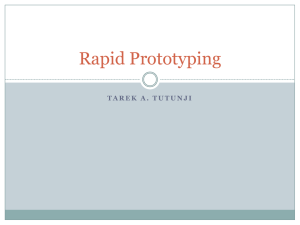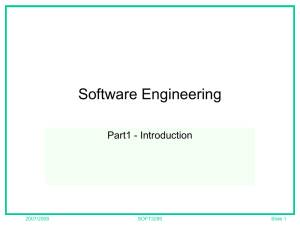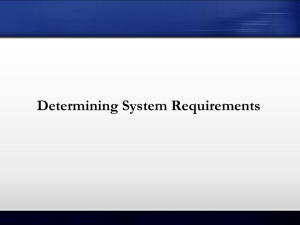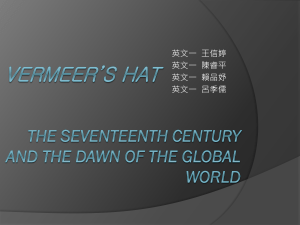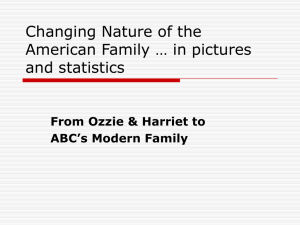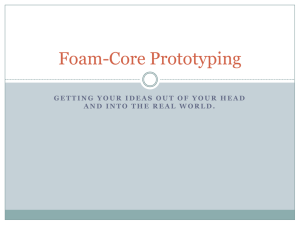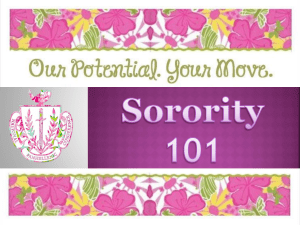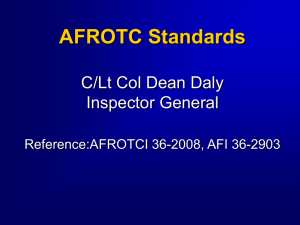Prototype Shop Safety Orientation
advertisement
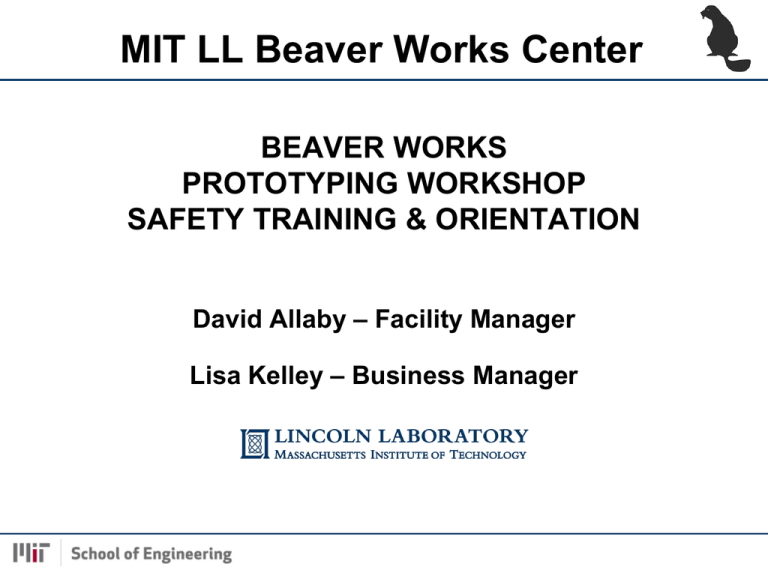
MIT LL Beaver Works Center BEAVER WORKS PROTOTYPING WORKSHOP SAFETY TRAINING & ORIENTATION David Allaby – Facility Manager Lisa Kelley – Business Manager Topics • Beaver Works Prototyping Workshop Description • Emergency Evacuation • Prototyping Workshop Access • Prototyping Workshop Safety Policies • Personal Safety Policies • General Shop Safety Guidelines BW Prototyping Workshop Orientation - 2 Beaver Works Prototyping Workshop • Beaver Works Prototyping Workshop is an unclassified work space that contains multiple pieces of equipment Drill Press Mill Band Saw Sanding Table Lathe Brake Shear Notcher 3D Printer Laser Cutter • Do-it-yourself approach to your project • Facility Manager to help/train on equipment BW Prototyping Workshop Orientation - 3 Evacuation & Muster Plan / Telephone Locations • Evacuation Routes/Muster Location – Refer to map below (a map is posted on the Main Entrance as well) – In case of evacuation please muster in the Quad Area outside Main Street Prototype Shop Research Area Class Rooms = Exit = Telephone BW Prototyping Workshop Orientation - 4 = Fire Extinguishers Beaver Works Safety Policy/Training EMERGENCY SAFETY PROCEDURES • Fire extinguisher locations – Main Entrance, straight back to the windows center – Research Area, next to eye wash station – Small Class Room, inside door on the wall side – Prototyping Workshop, Chemical work group room in the center back of the room • Emergencies – Dial 100 • MIT Police – Dial 31212 • 5 telephone locations (4 in the General Research Area, 1 in Prototyping Workshop. Locations shown on map in previous slide.) – Facility Manager’s office – Office #2 – VPN room – In General Research area, located along the windows – Prototyping Workshop – on the table to the right when you walk in We are in the process of adding two additional telephones in the Prototyping Workshop. BW Prototyping Workshop Orientation - 5 Prototyping Workshop Access • Prototyping Workshop Access Policy 1. Potential users must already have Access to General Research Laboratory 2. Potential users must attend this Prototyping Workshop Orientation 3. Users of industrial machining equipment must receive machine- specific training and evaluation by Facility Manager prior to being granted access. This will include going through the “Flashlight Program” if not already qualified in the Prototyping Workshop on machine-specific equipment 4. Approved users will be allowed to access the Prototyping Workshop in groups of 2 or more approved/trained users 24/7 when industrial machining equipment is in use. After hours, an authorized/trained graduate student must be present in the workshop per MIT policy 5. The number allowed in the Prototyping Workshop: Min 2 – Max 10 6. The Facility Manager will grant key access to specific industrial machining equipment when he determines that a user(s) is capable of using that specific equipment while abiding by all the safety policies and procedures. Keys cannot be given to other users without the permission of the Facility Manager 7. The Facility Manager can deny access if the policies and procedures are not followed BW Prototyping Workshop Orientation - 6 Prototyping Workshop Safety Policy • See Beaver Works Safety Policy (SP) BW001 for general rules • Prototyping Workshop rules – – – – – – – – – – – – – – – – – – Personal Protective Equipment (PPE) is required (safety glasses, gloves) Must sign in and pick up a “Panic” button that is to be worn at all times in the workshop Guarding required to be utilized No cell phones, Ipods or headphones Safety glasses must be worn at all times Wear ear protection when necessary Long hair must be pulled back No jewelry can be worn – including rings and watches No loose clothing – including ties Badges must be removed and placed in a designated location Must wear appropriate shoes (flat and toes must be covered) Gloves must be worn when necessary (never around equipment with rotating parts) Never work alone – the Prototyping Workshop uses the 2-person rule Never leave a machine running unattended Never use a rag near moving machinery Never use damaged machinery or tools – report any issues to the Facility Manager No food or drinks Dial x100 in case of Emergency BW Prototyping Workshop Orientation - 7 General Shop Safety Guidelines • • • • • • • • • • Safety Rules around Machines Machine Guarding Machine Installation Personal Protective Equipment Shop Housekeeping Fire Prevention Lockout/Tagout Compressed Air Safety Abrasive Grinding General Machine Safety BW Prototyping Workshop Orientation - 8 Safety Rules around Machines • Only operate a machine that you have been properly trained to use • Dress Safety – wear tucked in short-sleeved shirts and noncuffed pants. Long sleeves, gloves, neckties, scarves, badge lanyards, and jewelry can get caught in moving parts. Tie long hair back and use a hair net or hat BW Prototyping Workshop Orientation - 9 Safety Rules around Machines • • • Concentrate on what you’re doing and stay aware of what’s going on around you Perform another task if you’re tired and having trouble focusing Take your time. Rushing will only increase your chances of being injured or causing damage to the machine BW Prototyping Workshop Orientation - 10 Safety Rules around Machines • Never leave a running machine unattended • Let the machine stop completely by itself – never use your hands or a makeshift device to slow it down • Clean the machine when you have finished using it. A dirty machine is unsafe and uncomfortable to work on. Also, maintain good housekeeping in the shop BW Prototyping Workshop Orientation - 11 Safety Rules around Machines • Never lean on a machine for support • Do not run or joke around or near machinery • NO working alone in machine shops • No cell phones, Ipods or headphones • NO eating or drinking in work areas; and most importantly, • Use machine safety guards at all times. BW Prototyping Workshop Orientation - 12 Concept of Machine Guarding HAZARD MACHINE GUARD YOU The concept of machine guarding is to PREVENT you from coming in contact with hazards. BW Prototyping Workshop Orientation - 13 Machine Guarding Helps Protect Workers from incurring: • Cuts • Fractures • Electric shock • Chemical exposure • Eye injuries • Skin burns; and, • Amputation or loss of the use of an appendage BW Prototyping Workshop Orientation - 14 Sources of Machine Hazards • Shear points - edges of two objects are moved closely enough together to cut a soft material • Pinch points - two rotating objects move together and at least one of them moves in a circle • Wrap points - rotating shafts • Crush points - two objects come together. One of the objects may be stationary • Free wheels or fly wheels - parts continue to spin after the power is shut off • Springs - under compression will expand with great force when released, and springs that are stretched will contract rapidly when released • Hydraulic systems - fluid under very high pressure BW Prototyping Workshop Orientation - 15 Common Machine Hazards Crush point Pinch point Shear point Wrap point BW Prototyping Workshop Orientation - 16 Machine Guards • Covers and Plates – most common safeguard to prevent access to hazard • Interlocks – shuts down the equipment if a cover is opened • Emergency Stops – located near the operator to shut off machine • Lockout Procedures – locking out equipment to prevent accidents; equipment may still be energized BW Prototyping Workshop Orientation - 17 Common Machine Guards Guard doors on CNC Mill Belt guard on lathe Blade guard on miter saw Guard on abrasive wheel grinder BW Prototyping Workshop Orientation - 18 Machine Installations • Readily accessible “lockout” points are required to be installed and labeled at or very near the equipment • Services (pipes) shall be labeled BW Prototyping Workshop Orientation - 19 Personal Protective Equipment Hand Protection • • • • • • • • Never reach into energized or running machinery To remove chips, use a brush To remove ribbon, use pliers DO NOT feel for burrs If you drop something, let it go To change belt positions, throw disconnect To dress a tool, use a fixture or handle-mounted device For hot parts, use ALUMINIZED or Nomex gloves (asbestos gloves are no longer allowed) • For chemicals, use impermeable gloves such as nitrile or neoprene • When handling sharp tools, scrap or stock, use cut resistant gloves such as Kevlar. NEVER wear gloves when running a machine with rotating parts! BW Prototyping Workshop Orientation - 20 Personal Protective Equipment Eye and Face Protection • Safety glasses with side shields meeting “ANSI Z87” certification are required to be worn when working with any machine shop machinery – some areas require safety glasses to be worn upon entering the area • Replace defective eyewear immediately (scratched lenses, broken frame, etc.) • When grinding, safety glasses AND face shield are required • When welding, special ultraviolet (UV) welding helmets are required BW Prototyping Workshop Orientation - 21 Personal Protective Equipment Clothing and Foot Protection • • • • Wear only short sleeve or tight sleeve shirts DO NOT WEAR loose fitting clothing DO NOT WEAR jewelry on hands and arms DO NOT WEAR neck jewelry, badge lanyards or ties outside your shirt • Do NOT Wear open toe shoes • Keep long hair tied back or under hair net or hat BW Prototyping Workshop Orientation - 22 Shop Housekeeping • Keep aisles clear of furniture, equipment, and debris • Keep access clear to EXITS, fire extinguishers, eye wash/showers units • DO NOT allow scrap to accumulate on or around machines • DO NOT allow coolant or oil to accumulate on floor BW Prototyping Workshop Orientation - 23 Fire Prevention • • • • • Avoid grinding or sparks near flammable or combustible liquids Do not allow oily materials to accumulate Keep metal turnings in a dry, covered, metal container (drum) Keep access to fire extinguishers clear CLASS D Fire Extinguisher is used for combustible metal fires (e.g. magnesium) • Notify the Facility Manager if fire extinguishers are damaged or empty BW Prototyping Workshop Orientation - 24 Compressed Air Safety • Use only OSHA-Approved guns/nozzles that limit air pressure to 30 psi • DO NOT modify guns/nozzles • DO NOT put tape on gun nozzle • Brush away or vacuum chips before blowing chips • Wear safety glasses • Report leaking hoses to your supervisor • DO NOT blow off body or clothes with compressed air. Cuts can be blown open, causing severe injury and infections. Eyes can only withstand 4 psi before severe permanent damage occurs BW Prototyping Workshop Orientation - 25 Abrasive Grinding • Wear safety glasses AND face shield when grinding • The grinder shall be secured (bolted) to the work surface and electrically grounded • Ensure the tongue guard (top) is within 1/4” of the grinding wheel • Ensure that the work rest is within 1/8” of wheel • The maximum RPM rating of the wheel must be compatible with the RPM of the grinder motor • Keep end-plates in place • “Ring test” grinding wheels before use • Never grind on the side of the wheel BW Prototyping Workshop Orientation - 26 Machine Safety • All machines contain hazards from rotating parts, belts, pulleys, high voltage electricity, noise and compressed air • When using manual and/or CNC machines, basic safety precautions must always be followed to reduce the risk of personal injury and mechanical damage • Specific safety issues will be discussed during all training BW Prototyping Workshop Orientation - 27 Machine Safety • Only authorized personnel can work on a machine • Check for damaged parts and tools before operating the machine. Remove damaged tools from service • Some tools have RPM limits. DO NOT exceed these limits • Wear eye protection • Do not operate the machine unless the guards are in place. This includes the doors. Door interlocks should function properly • The Emergency Stop Button is for emergencies • Door(s) to the machine should be closed when machine is running. Never bypass door interlocks! Emergency Stop Button BW Prototyping Workshop Orientation - 28 Your Role and Responsibilities • Users – – – – – – – – – – Complete general and work area-specific training Sign in to shop and pick up a “Panic” button before proceeding Be familiar with all machines you are using Only use machines you are trained on Promptly report chemical exposures, accidents, incidents, and near misses to the Facility Manager Seek help at MIT Medical Department if injured at Beaver Works Clean up facility after each use No food or drink in the Prototyping Workshop No cell phones, Ipods or headphones Know where to find the first aid kits, fire extinguishers and telephones BW Prototyping Workshop Orientation - 29 Conclusion • Safety is the #1 priority and will be incorporated into all aspects of training and using equipment and tools at the Beaver Works Center • A two-man rule is always in effect when using the machines in the Prototyping Workshop • Contact the Facility Manager with any questions BW Prototyping Workshop Orientation - 30 Beaver Works User Agreement Prototype Shop Beaver Works is a do-it-yourself open laboratory space consisting of the following: • • • • • Prototyping Workshop Rapid Prototyping Area (Laser Cutter/3D Printer) Software Development Area Electronics Area Systems Development Area The Beaver Works Center serves as a single convenient, comprehensive, and open laboratory designed to foster innovation, collaboration, and creative problem solving. This area is available to students and staff for development, preprogram idea or concept validation, and unstructured curiosity driven prototyping. Each of the areas within Beaver Works is equipped with tools and equipment that provide the maximum utility to those students and staff looking to train, explore and/or prototype. As a student / staff member and potential user of Beaver Works, I Name agree on Date to attend all required safety orientations and to abide by all safety rules and regulations present to me by the Facility Manager. By signing this document, I also understand the potential hazards associated with the equipment within the Beaver Works facility and that by following the Safety Procedures and regulations I will be allowed to use the facility. Failure to follow the Beaver Works rules and regulations may result in my loss of access to the lab as determined by the Facility Manager. Signature: Date Facility Manger: Date BW Prototyping Workshop Orientation - 31
